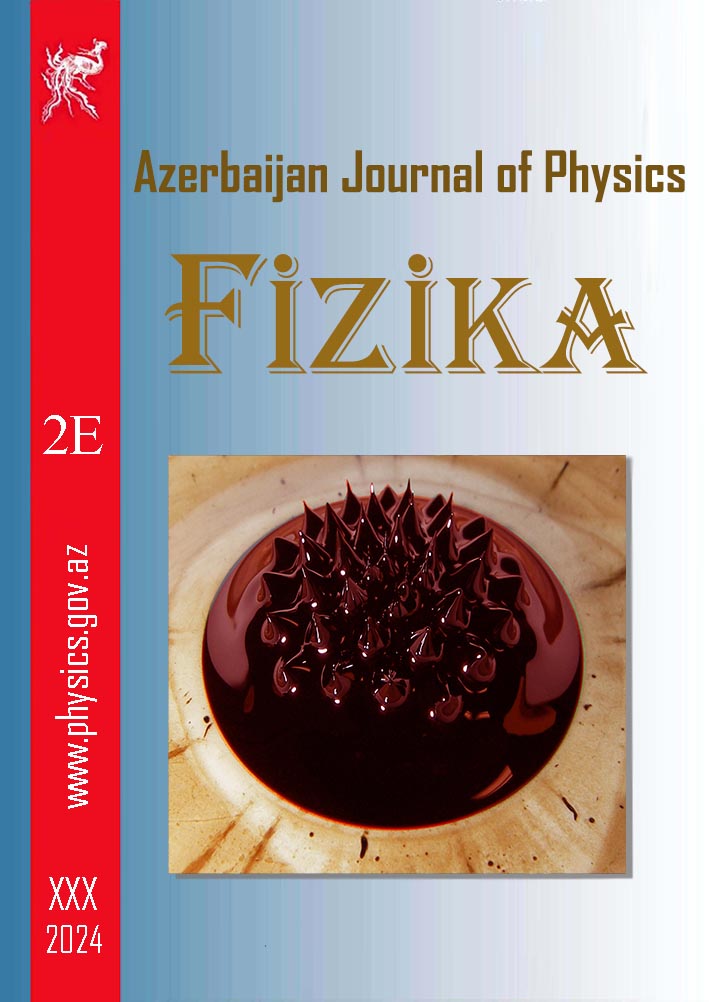ABSTRACT
The mechanism of formation of excess conductivity in cuprate high-temperature superconductors (HTSC) Y0,6Cd0,4Ba2Cu3O7-δ
and YBa2Cu3O7-δ was considered within the framework of the local pair model taking into account the Aslamazov-Larkin theory near Tc.
The temperature T0 of the transition from the 2D fluctuation region to the 3D region (the temperature of the 2D-3D crossover) is determined. The coherence lengths of the
fluctuation Cooper pairs ξc (0) along the c axis are calculated. It was shown that a partial substitution of Y by Cd in the Y – Ba – Cu – O system leads to a decrease
in ξc (0) by ~ 2 times (from 6.32 Ǻ to 3.18 Ǻ), as well as to the expansion as the region of existence pseudogaps and superconducting (SC) fluctuations near Tc.
The temperature dependence of the pseudogap Δ * (T) and the values of Δ * (Tc) are determined, and temperatures Tm corresponding to the maximum temperature
dependence of the pseudogap in these materials are estimated. The maximum values of the pseudogap in samples Y0,6Cd0,4Ba2Cu3O7-δ
and YBa2Cu3O7-δ are 34.56 meV and 28.4 meV correspondingly.
Keywords: superconductivity, pseudogap, excess conductivity, coherence length, composition.
PACS: 74.25. Fy, 74.20.Mn, 74.72. ± h, 74.25. ± q, 74.25.Jb
Received: 03.02.2020
AUTHORS & AFFILIATIONS
1. Institute of Physics of the National Academy of Sciences of Azerbaijan, 131, H. Javid Ave., Baku, AZ 1143
2. Azerbaijan Medical University, 23, Bakykhanov str., Baku, AZ 1022
E-mail: v_aliev@bk.ru
|
REFERENCIES
[1] E.B. Amitin, K.R. Zhdanov, A.G. Blinov et al. Low Temp. Phys., 31, 4, 323-326, 2005.
[2] M.V. Sadovsky. Physics-Uspekhi, 171, 539-564, 2001.
[3] M.R. Trunin. Physics-Uspekhi, 175, 10, 1017-1037, 2005.
[4] A.L. Soloviev, V.M. Dmitriev. Low Temp. Phys., 32, 6, 753-760, 2006.
[5] A.L. Solovjov, M.A. Tkachenko, R.V. Vovk, A. Chroneos. Physica C, 501, 24–31, 2014.
[6] He Rui-Hua., M. Hashimoto, H. Karapetyan et al. Science, 331, 1579-1583, 2011.
[7] A.A. Abrikosov. Physics-Uspekhi, 174, 11, 1233-1239, 2004.
[8] L.G. Aslamazov and A.L. Larkin. Physics Letters, 26A, 6, 238-239, 1968.
[9] S.A. Aliev, S.S. Ragimov, V.M. Aliev. AJP Fizika, 10, 4, 42-43, 2004.
[10] V.M. Loktev, V.M. Turkowski. Low Temp. Phys., 30, 3, 247-260, 2004.
[11] S. Hikami, A.I. Larkin. Modern Phys. Lett., V. B2, 693-697, 1988.
[12] B.Oh, K,Char, A.D.Kent et al. Phys. Rev. B37, 13, 7861-7864, 1988.
[13] A.L. Soloviev, V.M. Dmitriev, Low Temp. Phys., 35, 3, 227-264, 2009.
[14] A.A. Kordyuk, Low Temp. Phys., 41, 5, 417-444, 2015.
[15] D.D. Prokofiev, M.P. Volkov, Yu.A. Boykov. Solid State Physics, 45, 7, 1168-1176, 2003.
[16] V.V. Florentiev, A.V. Inyushkin, A.N. Taldenkov et al. Superconductivity: physics, chemistry, technology, 3, 10, part 2, 2302-2319, 1990.
[17] R. Peters and J. Bauer. Phys. Rev. B 92, 014511 - Published 22 July, 2015.
|
